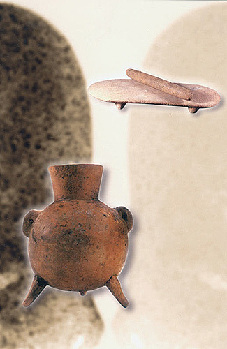Archaeological site of the Neolithic Age
Location:Xinzheng,HenanProvince
Period: 5,500-4,900 BC
Excavated in 1977
Significance: Peiligang Culture is named after the Peiligang Site. The site has provided an important clue for the study of the development of the early Neolithic cultures in the Central Plains, as well as their relationships with the Yangshao Culture of the Central Plains.
 |
| Stone saddle-quern and stone roller: implements for grinding grains (up); Red pottery pot: water vessel (bottom, height 14.3 cm) |
 Introduction
Introduction
Peiligang Site covers an area of about 20,000 square meters. The eastern part of it is ruins of ancient villages; the western part, tombs for clan members. After four excavations from 1977 to 1979, archaeologists have discovered 114 tombs, 1 kiln, 10 pits and several broken foundations of houses, together with which more than 400 pieces of cultural relics were unearthed, including stone wares, potteries and bone wares. The articles buried with the dead were mainly tools for production and daily use. Peiligang Culture is named after the site.
 About Xinzheng
About Xinzheng
Xinzheng lies in the center ofHenanProvince. It is a satellite city ofZhengzhou, capital ofHenan. To the north isZhengzhou, to the eastKaifeng, to the south Xuchang, and to the westLuoyang.
Xinzheng is the birthplace of Huangdi, the first ancestor of the Chinese people. 8,000 years ago the Peiligang Village of Xincun Town was established in the city ofXinzheng. Huangdi made Xinzheng his capital and began the fabulous Chinese culture. During the Spring and Autumn Period (770-446 BC), the State ofZhengand the State ofHanmade their capital here in Xinzheng for hundreds of years. Xinzheng is listed as the first of the Ten Ancient Capitals of China.
